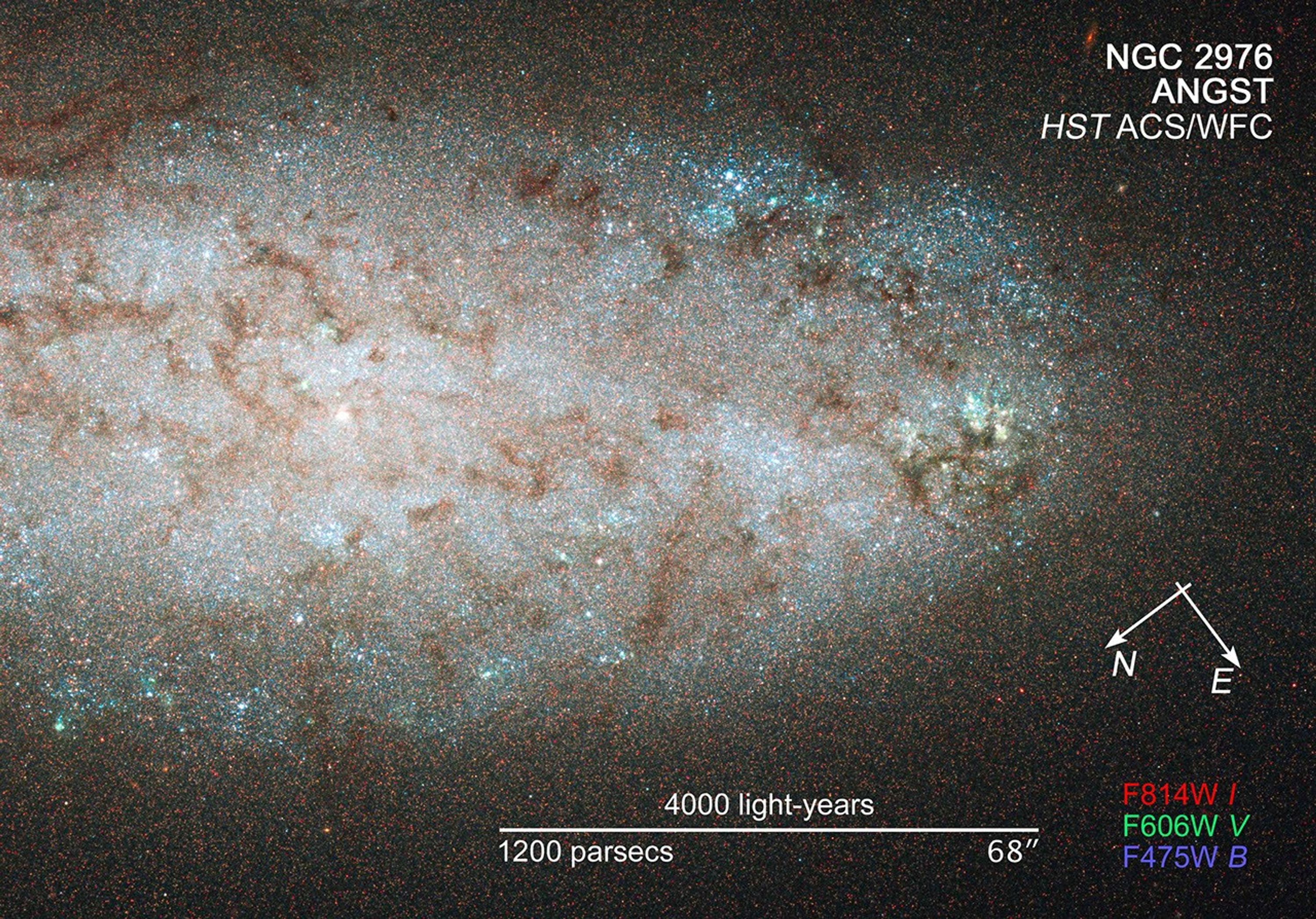1 min read
Star-Birth Party Almost Over in NGC 2976

NGC 2976 does not look like a typical spiral galaxy, as this NASA Hubble Space Telescope image shows.
In this view of the oddball galaxy's inner region, there are no obvious spiral arms. Dusty filaments running through the disk show no clear spiral structure. A raucous interaction with a neighboring group of hefty galaxies stripped away some gas and funneled the rest to the galaxy's inner region, fueling star birth about 500 million years ago. At the same time, the galaxy's outer regions stopped making stars because the gas ran out. Now, the inner disk is almost out of gas as new stars burst to life, shrinking the star-formation region to a small area of about 5,000 light-years around the core.
Astronomers pieced together the galaxy's star-formation story with the help of Hubble's sharp vision. The galaxy's relatively close distance to Earth allowed Hubble's Advanced Camera for Surveys (ACS) to resolve hundreds of thousands of individual stars. What look like grains of sand in the image are actually single stars.
Studying the individual stars allowed astronomers to determine their color and brightness, which provided information about when they formed. Based on this analysis, the astronomers reconstructed the star-making history for large areas of the galaxy.
The blue dots in the image are fledgling blue giant stars residing in the remaining active star-birth regions. NGC 2976 resides on the fringe of the M81 group of galaxies, located about 12 million light-years away in the constellation Ursa Major.
The observation is part of the ACS Nearby Galaxy Survey Treasury (ANGST) program. Data for the image were taken Dec. 27, 2006, to Jan. 10, 2007.
About the Object
- R.A. PositionR.A. PositionRight ascension – analogous to longitude – is one component of an object's position.09h 47m 15.45s
- Dec. PositionDec. PositionDeclination – analogous to latitude – is one component of an object's position.67° 54' 59.0"
- ConstellationConstellationOne of 88 recognized regions of the celestial sphere in which the object appears.Ursa Major
- DistanceDistanceThe physical distance from Earth to the astronomical object. Distances within our solar system are usually measured in Astronomical Units (AU). Distances between stars are usually measured in light-years. Interstellar distances can also be measured in parsecs.This image is 2.8 arcminutes (9,800 light-years or 3,000 parsecs) wide.
About the Data
- Data DescriptionData DescriptionProposal: A description of the observations, their scientific justification, and the links to the data available in the science archive.
Science Team: The astronomers who planned the observations and analyzed the data. "PI" refers to the Principal Investigator.This image was created from HST data from proposal 10915: J. Dalcanton (University of Washington, Seattle) and collaborators. - InstrumentInstrumentThe science instrument used to produce the data.HST>ACS/WFC
- Exposure DatesExposure DatesThe date(s) that the telescope made its observations and the total exposure time.December 27, 2006 - January 10, 2007, Exposure Time: 1.3 hours
- FiltersFiltersThe camera filters that were used in the science observations.F475W (B), F606W (V), and F814W (I)
- Object NameObject NameA name or catalog number that astronomers use to identify an astronomical object.NGC 2976
- Object DescriptionObject DescriptionThe type of astronomical object.Spiral Galaxy
- Release DateJanuary 14, 2010
- Science ReleaseHubble Catches End of Star-Making Party in Nearby Dwarf Galaxy
- Credit

The image is a composite of separate exposures made by the ACS/WFC instrument on the Hubble Space Telescope. Three filters were used to sample broad wavelength ranges in the near infrared. The color results from assigning different hues (colors) to each monochromatic image. In this case, the assigned colors are: Blue: F475W (B) Green: F606W (V) Red: F814W (I)

Share
Details
Claire Andreoli
NASA’s Goddard Space Flight Center
Greenbelt, Maryland
claire.andreoli@nasa.gov





























